White movement
| White movement Бѣлое движенiе Белое движение | |
|---|---|
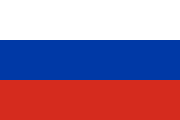 Russian flag commonly used by the Whites | |
| Leaders | Lavr Kornilov (1917–1918) Anton Denikin (1918–1920) Pyotr Wrangel (1920) In Transbaikal: Grigory Semyonov (1917–1921) Alexander Kolchak (1918–1920) Nikolai Yudenich (1919–1920) Also: Mikhail Diterikhs (1922) Anatoly Pepelyayev (1923) |
| Dates of operation | 1917–1923 |
| Ideology | Majority:
Factions: |
Kingdom of Serbs, Croats and Slovenes
Other states and factions: | |
| Opponents | 1922:
Makhnovschyna |
| Battles and wars | 1917–1923: Russian Civil War
Russian Imperial Army |
The White movement (Russian: pre–1918 Бѣлое движеніе / post–1918 Белое движение, romanized: Beloye dvizheniye, IPA: [ˈbʲɛləɪ dvʲɪˈʐenʲɪɪ]),[a] also known as the Whites (Бѣлые / Белые, Beliye), was a loose confederation of anti-communist forces that fought the communist Bolsheviks, also known as the Reds, in the Russian Civil War (1917–1923) and that to a lesser extent continued operating as militarized associations of rebels both outside and within Russian borders in Siberia until roughly World War II (1939–1945). The movement's military arm was the White Army (Бѣлая армія / Белая армия, Belaya armiya), also known as the White Guard (Бѣлая гвардія / Белая гвардия, Belaya gvardiya) or White Guardsmen (Бѣлогвардейцы / Белогвардейцы, Belogvardeytsi).
During the Russian Civil War, the White movement functioned as a big-tent political movement representing an array of political opinions in Russia united in their opposition to the Bolsheviks—from the republican-minded liberals and Kerenskyite social democrats on the left through monarchists and supporters of a united multinational Russia to the ultra-nationalist Black Hundreds on the right.
Following the military defeat of the Whites, remnants and continuations of the movement remained in several organizations, some of which only had narrow support, enduring within the wider White émigré overseas community until after the fall of the European communist states in the Eastern European Revolutions of 1989 and the subsequent dissolution of the Soviet Union in 1990–1991. This community-in-exile of anti-communists often divided into liberal and the more conservative segments, with some still hoping for the restoration of the Romanov dynasty.
Structure and ideology
In the Russian context after 1917, "White" had three main connotations which were:
- Political contra-distinction to "the Reds", whose Red Army supported the Bolshevik government.
- Historical reference to
- The white uniforms of Imperial Russia worn by some White Army soldiers.
Ideology
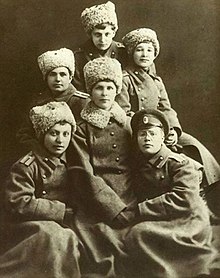
Above all, the White movement emerged as opponents of the Red Army.[7] The White Army had the stated aim to reverse the October Revolution and remove the Bolsheviks from power before a constituent assembly (dissolved by the Bolsheviks in January 1918) could be convened.[8] They worked to remove Soviet organizations and functionaries in White-controlled territory.[9]
Overall, the White Army was nationalistic[10] and rejected ethnic particularism and separatism.[11] The White Army generally believed in a united multinational Russia and opposed separatists who wanted to create nation-states.[12]
The propaganda service of the Volunteer Army, the
British parliamentary influential leader
[M]y task in winning support in Parliament for the Russian Nationalist cause will be infinitely harder if well-authenticated complaints continue to be received from Jews in the zone of the Volunteer Armies.[14]
However, Denikin did not dare to confront his officers and remained content with vague formal condemnations.
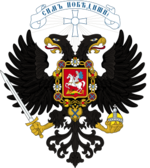
Aside from being anti-Bolshevik and anti-communist
The movement had no set foreign policy. Whites differed on policies toward the
Some
Unlike the Bolsheviks, the White Armies did not share a single ideology, methodology, or political goal. They were led by conservative generals with different agendas and methods, and for the most part they operated quite independently of each other, with little coordination or cohesion. The composition and command structure of White armies also varied, some containing hardened veterans of World War I, others more recent volunteers. These differences and divisions, along with their inability to offer an alternative government and win popular support, prevented the White armies from winning the Civil War.[22][23]
Structure
White Army

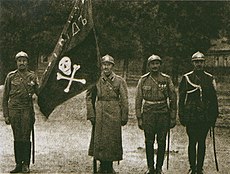
The
The White movement had access to various naval forces, both seagoing and riverine, especially the Black Sea Fleet.
Aerial forces available to the Whites included the Slavo-British Aviation Corps (S.B.A.C.).[25] The Russian ace Alexander Kazakov operated within this unit.
Administration
The White movement's leaders and first members
The White generals never mastered administration;[27] they often utilized "prerevolutionary functionaries" or "military officers with monarchististic inclinations" for administering White-controlled regions.[28]
The White Armies were often lawless and disordered.[8] Also, White-controlled territories had multiple different and varying currencies with unstable exchange-rates. The chief currency, the Volunteer Army's ruble, had no gold backing.[29]
Ranks and insignia
Theatres of operation

The Whites and the Reds fought the Russian Civil War from November 1917 until 1921, and isolated battles continued in the Far East until June 1923. The White Army—aided by the Allied forces (Triple Entente) from countries such as Japan, the United Kingdom, France, Greece, Italy and the United States and (sometimes) the Central Powers forces such as Germany and Austria-Hungary—fought in Siberia, Ukraine, and in Crimea. They were defeated by the Red Army due to military and ideological disunity, as well as the determination and increasing unity of the Red Army.
The White Army operated in three main theatres:
Southern front
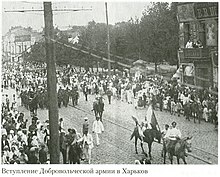
White organising in the South started on 15 November 1917, (Old Style) under General Mikhail Alekseyev. In December 1917, General Lavr Kornilov took over the military command of the newly named Volunteer Army until his death in April 1918, after which General Anton Denikin took over, becoming head of the "Armed Forces of the South of Russia" in January 1919.
The Southern Front featured massive-scale operations and posed the most dangerous threat to the Bolshevik Government. At first it depended entirely upon volunteers in Russia proper, mostly the Cossacks, among the first to oppose the Bolshevik Government. On 23 June 1918, the Volunteer Army (8,000–9,000 men) began its so-called Second Kuban Campaign with support from
After General Denikin's attack upon Moscow failed in 1919, the Armed Forces of the South of Russia retreated. On 26 and 27 March 1920, the remnants of the Volunteer Army evacuated from Novorossiysk to the Crimea, where they merged with the army of Pyotr Wrangel.
Eastern (Siberian) front
The Eastern Front started in spring 1918 as a secret movement among army officers and right-wing socialist forces. In that front, they launched an attack in collaboration with the
Northern and Northwestern fronts
Headed by
Post-Civil War

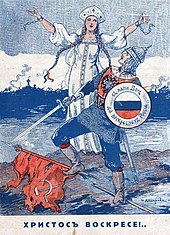
The defeated anti-Bolshevik Russians went into exile, congregating in Belgrade, Berlin, Paris, Harbin, Istanbul, and Shanghai. They established military and cultural networks that lasted through World War II (1939–1945), e.g. the Harbin and Shanghai Russians. Afterward, the White Russians' anti-Communist activists established a home base in the United States, to which numerous refugees emigrated.

Moreover, in the 1920s and the 1930s the White Movement established organisations outside Russia, which were meant to
After the war, active anti-Soviet combat was almost exclusively continued by the
Prominent people
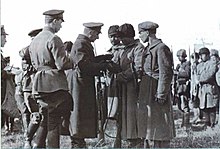
- Mikhail Alekseyev
- Vladimir Antonov
- Nicholas Savich Bakulin
- Pavel Bermondt-Avalov
- Stanisław Bułak-Bałachowicz
- Anton Denikin
- Mikhail Diterikhs
- Mikhail Drozdovsky
- Alexander Dutov
- Dmitrii Fedotoff-White
- Ivan Ilyin
- Nikolay Iudovich Ivanov
- Alexey Kaledin
- Vladimir Kantakuzen
- Vladimir Kappel
- Alexander Kolchak
- Lavr Kornilov
- Pyotr Krasnov
- Mikhail Kvetsinsky
- Alexander Kutepov
- Anatoly Lieven
- Konstantin Mamontov
- Sergey Markov
- Vladimir May-Mayevsky
- Evgeny Miller
- Konstantin Petrovich Nechaev
- Viktor Pokrovsky
- Leonid Punin
- Aleksandr Rodzyanko
- Grigory Semyonov
- Andrei Shkuro
- Roman von Ungern-Sternberg
- Pyotr Nikolayevich Wrangel
- Sergei Wojciechowski
- Nikolai Yudenich
Related movements
After the
See also
- Russian State (1918–1920)
- 1st Infantry Brigade (South Africa)
- Allied intervention in the Russian Civil War
- Basmachi movement
- Czechoslovak Legions
- Estonian War of Independence
- Finnish Civil War
- Grand Orient of Russia's Peoples
- Great Siberian Ice March
- Italian Legione Redenta
- Russian All-Military Union
- Russian diaspora
- Red Terror
- Soviet–Ukrainian War
- White Terror (Russia)
- Ukrainian War of Independence
Notes
- ^ The old spelling was retained by the Whites to differentiate from the Reds.
References
Footnotes
- ISBN 978-963-7326-14-1. Retrieved 18 March 2012.
Then there occurred another story which has become traumatic, this one for the Russian nationalist psyche. At the end of the year 1918, after the Russian Revolution, the Chinese merchants in the Russian Far East demanded the Chinese government to send troops for their protection, and Chinese troops were sent to Vladivostok to protect the Chinese community: about 1600 soldiers and 700 support personnel.
- ^ "The Tragedy of Albania's Russian Community". Russkiy Mir Foundation. 19 September 2008. Archived from the original on 12 July 2018. Retrieved 12 July 2018.
- ^ Sven Anders Hedin, Folke Bergman (1944). History of the expedition in Asia, 1927–1935, Part 3. Stockholm: Göteborg, Elanders boktryckeri aktiebolag. pp. 113–115. Retrieved 2010-11-28.
- ISBN 1-55655-674-8. Retrieved 28 October 2010.
- ISSN 0340-6490. Retrieved 31 July 2015.
It was Ivan III (1462–1505) who is well known as the first one to present himself as a tsar to foreigners, though it must be accepted that his use of the title was very sparse.
- ISSN 0340-6490. Retrieved 31 July 2015.
[...] the brief mention that the Muscovite ruler is by some called 'the White King' ('albus rex').
- ^ a b Kenez 1980.
- ^ a b Christopher Lazarski, "White Propaganda Efforts in the South during the Russian Civil War, 1918–19 (The Alekseev-Denikin Period)", The Slavonic and East European Review, Vol. 70, No. 4 (Oct., 1992), pp. 688–707.
- ^ Viktor G. Bortnevski, "White Administration and White Terror (The Denikin Period)", Russian Review, Vol. 52, No. 3 (Jul., 1993), pp. 354–366.
- ^ Kenez 1980, p. 74.
- ^ Christopher Lazarski, "White Propaganda Efforts," 689.
- ^ Kenez 1980, p. 62.
- ^ Rubenstein, Richard L., and John K. Roth. Approaches to Auschwitz: The Legacy of the Holocaust. London: SCM, 1987, p. 138.
- ISBN 9780714632544. Archivedfrom the original on 2016-05-21.
- ^ Christopher Lazarski, "White Propaganda Efforts," 690.
- ^ Kenez 1980, pp. 58–59.
- ^ "Первая лекция историка К. М. Александрова о Гражданской войне. Часть первая". www.belrussia.ru. 18 January 2010. Retrieved 3 February 2024.
- ^ Kenez 1980, p. 69.
- ^ Предисловие // Красный террор в годы Гражданской войны: По материалам Особой следственной комиссии по расследованию злодеяний большевиков. / Под ред. докторов исторических наук Ю. Г. Фельштинского и Г. И. Чернявского — London, 1992.
- ^ Kenez 1980, p. 59.
- ^ Kenez, Peter, Civil War, 90.
- ^ Двухнедѣльный военный и военно-морской журналъ «Часовой»: органъ связи русскаго воинства за рубежомъ подъ ред. В. В. Орѣхова и Евгенія Тарусскаго, — Paris, 1 мая 1932. — № 79. Archived 2010-12-17 at the Wayback Machine
- Большая российская энциклопедия: В 30 т. Т. 3: «Банкетная кампания» 1904 — Большой Иргиз / Председатель Науч.-ред. совета Ю. С. Осипов, отв. ред. С. Л. Кравец ed.). М.: Большая Российская энциклопедия.
- ^ Kenez, Peter, Civil War, 18–22.
- ^ "The R.A.F. in Russia". The Aeroplane. 17 (1): 82. 1919. Archived from the original on 27 June 2014. Retrieved 9 February 2014.
Soon after landing we started to recruit for the Slavo-British Aviation Corps (S.B.A.C.) [...].
- ^ Kenez, Peter, Civil War, 18.
- ^ Kenez 1980, p. 65.
- ^ Viktor G. Bortnevski, White Administration and White Terror, 360.
- ^ Kenez, Peter, Civil War, 94–95.
- S2CID 144274571.
Bibliography
- Kenez, Peter (1980). "The Ideology of the White Movement". Soviet Studies. 32 (32): 58–83. .
- Kenez, Peter (1977). Civil War in South Russia, 1919–1920: The Defeat of the Whites. Berkeley: University of California Press.
- Kenez, Peter (1971). Civil War in South Russia, 1918: The First Year of the Volunteer Army. Berkeley: University of California Press.
